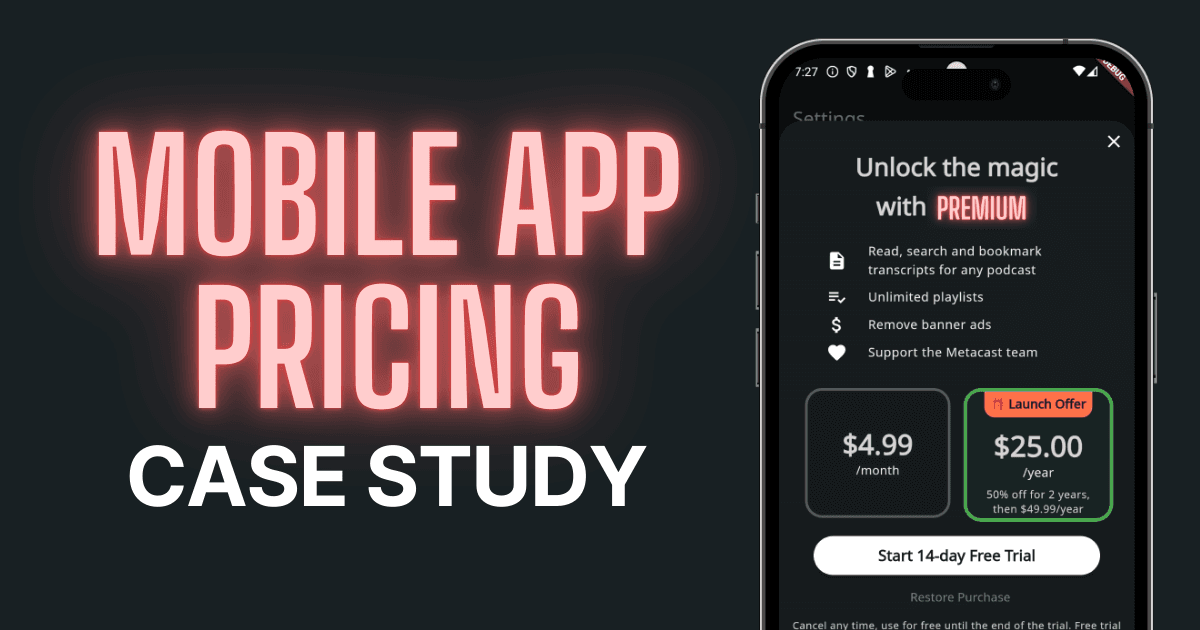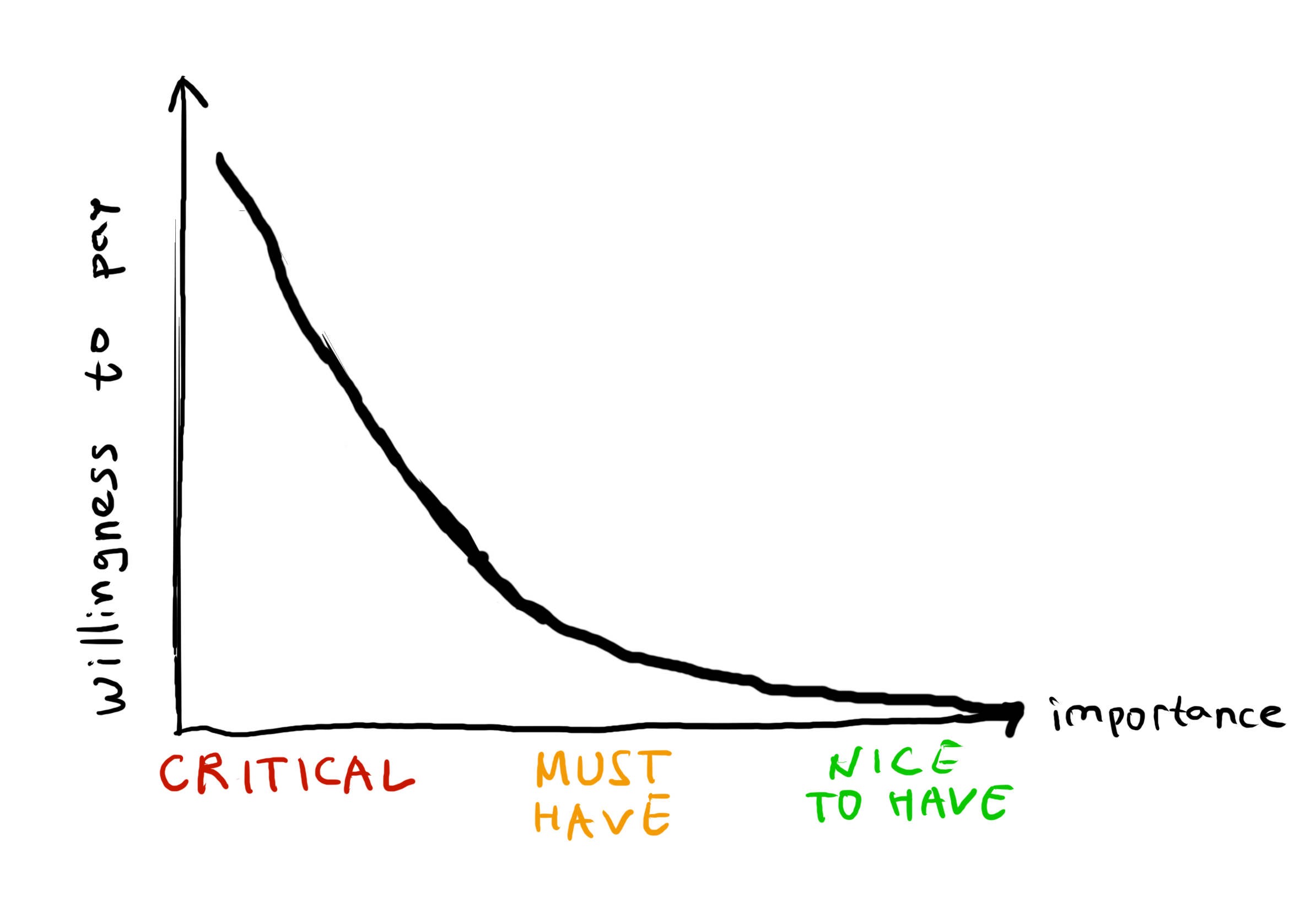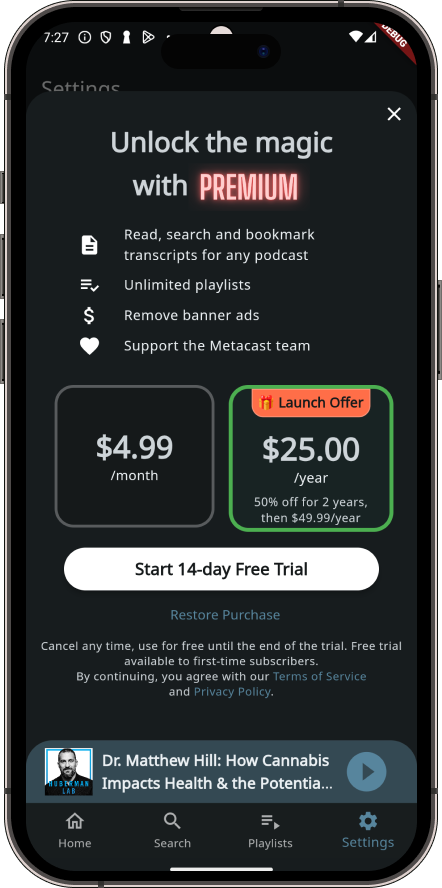Mobile app pricing case study
How we chose pricing tiers, the optimal price, discounts, free trial, special launch pricing, etc. for Metacast podcast app

Table of Contents
- Context: Business model and value prop
- How many pricing tiers should an app have?
- What is the optimal price for a mobile app subscription?
- Why we use 99 cents — $4.99 vs. $5.00?
- How to set the discount for an annual subscription?
- How long should a free trial be?
- How to set the special launch pricing?
- Next steps
- Follow our journey
In this "behind the scenes" post, we'll break down the entire thought process of pricing the Metacast podcast app.
You'll learn why we chose the $4.99 per month / $49.99 per year price point, how we thought about the launch pricing, why our prices end with .99, why our free trial is 2 weeks, and how we set pricing outside the United States.
At this stage, we are still testing whether people will be paying for Metacast Premium with the current set of features and whether the price point is right. We're running an experiment and documenting our findings in public.
Context: Business model and value prop
Before we get into pricing, let's first look at the business model and the value proposition, so you have an idea of what we're charging for.
Metacast is a podcast app for iOS and Android optimized for people who listen to a lot of information-dense podcasts and want to get the most out of their listening.
The podcast listening functionality is free to all users, whereas more advanced features are offered on a "freemium" basis — you can use them in a limited way, but to unlock the full capability of the app, you must subscribe to Metacast Premium.
The value proposition of Metacast vs. other apps:
- UX optimized for knowledge podcasts — our user experience combines audio and text transcripts and makes it really easy to switch between reading and listening, save bookmarks for later use, share quotes, or search for content inside an episode.
- Transcripts for every episode — whether you're listening to a super popular podcast or a niche show that has 5 listeners, Metacast will have a transcript for you if you're a Premium subscriber.
- Simple yet powerful playlists — in the next few months, we'll be adding powerful playlist-based workflows to help you organize your listening.
- Podcasts-only app — unlike some other big apps, we don't mix podcasts with music, audiobooks, and other types of content. Metacast is dedicated to podcasts, so we can fine-tune our UX for the podcast listening use case.
Our aspiration is to build the most intuitive yet powerful podcast app in the world. Our ambition is to stay small and independent, and dedicate the next decade of our lives (or more!) to podcasting. We're just getting started.
Now, let's get into pricing decisions.
How many pricing tiers should an app have?
When we first started looking at pricing, we considered multiple tiers:
- Free — limited access to advanced features, visual ads in the app ($0)
- Ad-free — same as Free, no visual ads ($1.99)
- Premium — unlimited access to advanced features, no visual ads ($4.99)
- Supporter — same as Premium at twice the price ($9.99) for users who want to go above and beyond in supporting our small independent team
First, we removed the ad-free tier. Leading up to the launch, we decided to punt visual ads until later, so this tier naturally fell off.
Later, we also removed the Supporter tier. Getting a bit of extra cash from super fans would've been nice but it'd inevitably have made the UX and purchase experience more confusing.
In the end, we reduced our paid offering to a single choice — Metacast Premium.
Less is more. Simple is king.
What is the optimal price for a mobile app subscription?
Even before we started building Metacast, we did some financial projections and sensitivity analysis at different price points.
We modeled revenue according to the Price Elasticity of Demand from Microeconomics 101 — lower price leads to more paying customers, higher price leads to fewer paying customers.
We based our assumptions on how much other apps charge for subscriptions. We looked not just at podcasting apps, but also at note-taking apps, productivity apps, and various consumer apps we personally pay for.
The intersection of our research and financial model resulted in a price point between $4 and $7 per month (all prices in this post are in USD). Psychologically people are used to paying this much for apps already, and this price range offers us a path to profitability with a reasonable number of users.
Should we charge less or more?
When we were playing with pricing, we put the maximum price of the range ($6.99/month) into the app's purchase experience. We installed the app on our phones and assessed how it made us feel.
$6.99/month felt too expensive.
The reason for this perception is that an awesome podcast app is somewhere between must-have and nice-to-have on the scale of importance. It solves a real problem, but can users live without it? Yes, they can.
People are less likely to pay for something they deem "nice-to-have." So, we have to be realistic about how much it is reasonable to charge for Metacast.

In the end, $4.99 made us feel good. It also made sense from the revenue perspective (if the assumptions in our model are correct).
Coffee price as a reference point for app pricing
You can frequently hear developers comparing subscription prices to coffees. Like, "get [awesome value] for a price of a latte."
We always thought the coffee reference point made sense. Our target audience is professionals who earn a good living and use podcasts for education and self-improvement. A stereotypical office worker stops at a coffee shop on the way to work to grab a cup of joe. Measuring app's price in cups of coffee creates a familiar anchor in people's minds (or so the startup wisdom says).
On our podcast episode about pricing, we compared our Premium price to a "stale Starbucks drip." Most people from our target audience in North America and Europe can afford it. It also serves as a great reference point for international pricing (keep reading).
Pricing in other countries
Residents of different countries have different purchasing power. While five bucks can be nothing to a professional in New York, it's a lot of money for someone in a small town in India or Peru.
Google Play Store and Apple App Store let you set country-specific pricing. We looked at the intimidating pricing form on the Apple App Store Connect and realized it's a tedious exercise that we're likely to get wrong anyway. At launch, we set the same price for all countries, converted to their local currencies automatically by the app stores.
In our podcast, we said that we're willing to lower the price in specific countries with some crowd sourcing help from the users. We asked them to send us a note with a picture of a coffee shop menu. We'll be happy to look at those requests and lower the prices to make the app affordable everywhere in the world.
While asking for coffee shop pictures may sound silly, we think that if we ever receive coffee shop pictures, they'll make for great community engagement and social media content.
P.S. We've not received any pictures yet. If you feel like Metacast should be cheaper in your country, please take a picture at your local Starbucks or hipster coffee shop and contact us.
Why we use 99 cents — $4.99 vs. $5.00?
Everyone who's ever been in a supermarket in North America is used to prices that end with .99. Pretty much all apps in the App Store have prices ending in .99 too. So, it must be working, right?
Brady Hodges, Assistant Professor at the University of Missouri, writes in his article .99-ending prices: Are they really as effective as we assume?:
There has been a long-standing debate among researchers regarding what makes prices ending in .99 so attractive to consumers. Some argue that consumers tend to focus on the left digits, rounding the .99 down (e.g., viewing $18.99 as $18). Others say that consumers pay attention to the .99, rounding the price to its nearest whole number, perceiving the small difference as a discount, or even associating the .99 ending with an “on sale” or low-price appeal (e.g., viewing $18.99 as $19).
What caught my eye is that researchers don't doubt the effectiveness of the .99 pricing, but rather argue about the cause for its effectiveness. For us, it's a good enough justification to go with the flow.
We briefly looked at using a whole number price (e.g. $5 even), which is often used in the luxury goods and service industries. A whole price indicates "completeness" and has a luxury feel to it. We didn't feel like it made sense for us at such a low price point.
How to set the discount for an annual subscription?
Obviously, we want users to commit to a full year of subscription. This way, we get more revenue at the sign-up time and have a full year to manage churn before users need to renew.
There must be some give-and-take with the user. An annual subscription has to be a good deal.
We've seen two approaches:
- Good discount — discounts usually range from 20% to 50%. The most common we've seen is "two months free" where paying an annual subscription costs as much as paying the monthly price for 10 months.
- No monthly pricing at all — some apps, notably 1Password, only have an annual fee. To our earlier point above, an app like 1Password is between critical and must-have on the scale of importance, so they can afford to charge a large amount upfront.
Ideally, we'd love to treat our annual subscribers well and give them a deep discount. We recently paid an annual fee for Descript at 35% off compared to the monthly pricing. It felt like a really good deal.
But we have operating costs and at the current scale, we cannot afford charging too little purely from a cost management perspective.
We settled on what most other apps do — the annual subscription is $49.99, "two months off" compared to the monthly pricing.
Also, $49.99 is a pretty number. It made us feel good.
How long should a free trial be?
Let me begin by saying that we strongly dislike apps that don't let us properly test drive them before asking for a payment. In our opinion, a free trial is absolutely necessary for users to get a feel for the value before making a monetary commitment.
Listening to a long podcast episode can sometimes take multiple days. Listening to a couple episodes can take a week. We wanted to give users some space when they sign up for Metacast Premium. A two-week trial period seemed reasonable, so we settled on two weeks.
Whether you sign up for monthly or annual subscription, with or without our special launch pricing deal, you get a two-week trial period before making a payment.
How to set the special launch pricing?
Prior to public launch on Android, Metacast had been in private beta for a year and in public beta for half a year. Our beta users, especially the very early ones, jumped hoops to use the app and were patient with many bugs that we fixed thanks to their feedback.
We wanted to give them a special treatment with a launch pricing deal. However, when we looked at what it'd take to implement discount codes, we thought it'd be easier to give special launch pricing to everyone without discriminating between existing and new users.
When setting the launch price, we wanted the price to be attractive from a monetary perspective, but we also wanted to incentivize a longer commitment.
We made the launch pricing only apply to annual subscriptions and arrived at a deal that made us feel good — $25 for the first two years (50% off the regular annual price). By signing up, you pay for a year and have an option to renew at the same discounted price for another year. If you cancel, you lose the option to use the discount.
The drawback of our launch pricing is that it's somewhat hard to explain in a short sentence.
Actually, it's 51% off...
If you look at our app or the announcement blog post, the launch pricing is 51% off (not 50%). The reason for this is somewhat silly, but it highlights our obsession with UX.
When we configured the 50% off deal in Google Play Console, the price was displayed as $25.00 in the app. Even though it's a whole number, it was showing decimal points. It drove me crazy.

I wanted to fix this, but it turned out that price formatting method from RevenueCat's Flutter SDK does not support displaying whole numbers. Writing our own currency formatter seemed unreasonable. We "fixed" the problem by adding an extra percentage point to the discount to introduce a decimal part to the price, making the launch price $24.50.
Next steps
We launched Metacast on Android just a couple of weeks ago. Everything written above is being put to the test as you're reading this.
Stay tuned!
Follow our journey
- Watch/listen to our CTO Arnab and me talk about pricing on episode 59 of the Metacast: Behind the Scenes podcast
- Join our r/metacastapp subreddit for more build-in-public posts
- Subscribe to our newsletter
- Follow me on LinkedIn, X or Threads
